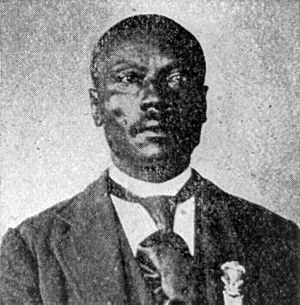Henry Johnson (Buffalo Soldier) facts for kids
Quick facts for kids
Henry Johnson
|
|
|---|---|

Sergeant Henry Johnson
|
|
| Born | June 11, 1850 Boydton, Virginia |
| Died | January 31, 1904 (aged 53) |
| Place of burial | |
| Allegiance | United States of America |
| Service/ |
United States Army |
| Years of service | 1866–1898 |
| Rank | Sergeant |
| Unit | 9th Cavalry Regiment 10th Cavalry Regiment |
| Battles/wars | Indian Wars |
| Awards | Medal of Honor |
Henry Johnson (born June 11, 1850 – died January 31, 1904) was a brave Buffalo Soldier in the United States Army. He received the Medal of Honor, which is America's highest award for military bravery. He earned this award for his actions during the Indian Wars in the western United States. Buffalo Soldiers were African American soldiers who served in the U.S. Army after the Civil War.
Contents
Who Was Henry Johnson?
Early Army Days
Henry Johnson was born in Boydton, Virginia. In 1866, when he was 16, he joined the Army in Detroit, Michigan. He was one of the first members of the 10th Cavalry Regiment.
Fighting in the Cheyenne Wars
Johnson fought with the 10th Cavalry against the Cheyenne people. This happened near the Republican River. In June 1877, Johnson joined the 9th Cavalry Regiment. His troop was stationed at Fort Wallace and patrolled southern Colorado.
The Meeker Massacre
On September 29, 1879, a group of Ute warriors attacked about 175 soldiers. This ambush happened near Milk Creek. At the same time, the Utes also killed the Indian agent and his employees at a nearby Ute reservation.
The soldiers near the creek quickly built a defense. They used their wagons and dead animals to create a safe area. The Utes continued to attack their remaining animals.
A Heroic Act
Captain Francis Dodge, Sergeant Johnson, and their D Troop arrived on October 2, 1879. They managed to enter the camp without being shot. For the next three days, D Troop's animals were also attacked. Only four wounded horses were left.
Sergeant Johnson was given the important job of securing the outposts. These were key defense points for the camp. Under heavy fire from the Utes, he bravely moved around the camp. He checked on his men and gave them instructions. On October 5, more troops arrived, and the Ute attackers left.
Johnson received the Medal of Honor on September 22, 1890. This was for his brave actions during the Battle of Milk Creek in Colorado. His Medal of Honor citation says:
Voluntarily left fortified shelter and under heavy fire at close range made the rounds of the pits to instruct the guards, fought his way to the creek and back to bring water to the wounded.
At the time he received the award, he was a private. He had been promoted to sergeant three times. However, he was demoted for an incident before receiving the medal.
Later Military Life
Shortly after the battle at Milk Creek, Johnson and D Troop went to New Mexico. For the next two years, they fought against the Apaches in Victorio's War. He left the Army in January 1883.
Continuing the Fight
Johnson rejoined the Army two months later with the 10th Cavalry. He was stationed at Fort Grant to fight the Apaches again. After five more years of service, he joined the 9th Cavalry in K Troop in 1888.
K Troop patrolled the Pine Ridge Sioux Reservation during the winter of 1890–1891. Then, they moved to Fort Myer in Virginia. K Troop returned to Fort Robinson in 1893.
Retirement and Legacy
Johnson's final five-year enlistment ended in 1898. He retired that same year to Washington, D.C.. He passed away on January 31, 1904. Henry Johnson is buried in Arlington National Cemetery, Arlington, Virginia. His grave is in section 23, lot 16547.

